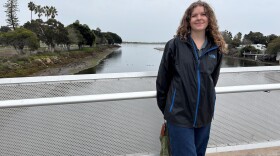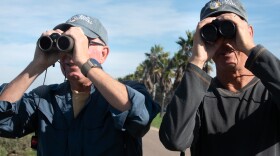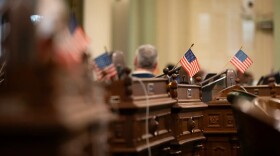A second meeting is planned tonight on the question of reopening the underground grass storage field in the San Fernando Valley. Last nights meeting could be described as rowdy, rockets and filled with people who do not want to see the facility reopened anytime soon. Many people who attended the meeting say they are still suffering health effects of the largest known gas release in history. Ingrid low back up I Newsource has covered this extensively. She was there. Welcome to the program. Thank you. Can you give us a reminder about the story? The leak -- leak was discovered in 2015 and it took months to. That is right. The well failed and began spewing methane. It is invisible. Soon residents were available that something was wrong. The company was also aware. It was hard to get this well under control. 6000 people had to leave their homes. If you remember, they closed to elementary schools and completely relocated all those children to other places temporarily. What is the purpose of the underground storage facility? You can get your natural gas without underground storage. That would mean that all of the gas used for those purposes would have to come right in time from the pipelines, from the gas fields. You would have to have a delicate balance of what you need and what is being delivered at any given time. With an underground storage field, you have a big cushion that you can draw on whenever you need gas. Do we know why the leak happened in the first place? Let's talk about what a well is first. It is a piece of steel. In this case it was a 7 inch diameter piece of steel. I think we can say with certainty that the 7 inch steel pipe for this well broke. It either war through were developed a crack of some kind. Then the pressure of the gas underground made that bigger and it started flowing through the earth and into the air. You described the crowd as raucous. What happened? People came apparently organized and planned to take over the meeting. Release quite a number of people did. What they really wanted was for it to be a solid testimony about their ongoing health issues and one of the people who got a chance to speak was a long time -- longtime resident. The budget -- bloody noses, severe headaches, sore throat, dizzy spells, sleepless nights, as of today we're still trying to find out what are the types of chemicals that were in that well. We still do not know. He was one of only a few people who got a chance to speak people did take over the meeting. They did not use the agenda that the organizers had come in with. There were people who got a chance to speak who actually are in favor of reopening the field. They were shouted down. On behalf of our 3 million families who rely on all sorts of energy, I ask that you support the safe reopening. That was Nancy Fernandez. Shortly after she spoke, the meeting was shut down abruptly long before it was supposed to be over. One voice that we did here before that happened, I thought this was kind of remarkable was the deputy director for health protection. He said he expressed a surprising lack of confidence in a certain part of the process. He said that we really don't have people with the right health expertise involved in making the decision about reopening the gas field. I wish we had a state regulatory agency for these types of facilities that was health oriented. [ Applause ] How quickly would Southern California like to reopen the field? They say it respects the process which involves the public process such as the meeting last night and another one tonight. They feel the field is ready to be reopened. They have done extensive work including testing all the wells. Some that failed have been taken out of service permanently meeting concrete has been poured into them and they will never be reopened. So far 34 wells at the facility have passed the test. They have new well pipe, new cementing or have been plugged. If and when it does reopen, it will only have one third the capacity of gas that it had prior to this disaster. So you mentioned that we will have another meeting tonight on this subject. That is in Woodland Hills? Should we expect anything different at tonight's meeting? I am not sure what will happen but last night was really different from a number of other large and he did public meetings. Usually there has been more respect. Ingrid, thank you.



A fed-up crowd of San Fernando Valley residents commandeered the first of two meetings on the reopening of the Aliso Canyon underground gas storage field Wednesday night, rising to their feet, roaring, “Shut it down!”
The crowd of about 350, packed to standing room, overwhelmed a mediator hired to shepherd the meeting. They demanded more time to describe health problems, they said, still plague them a year after a blown gas well in hills above their home was finally brought under control.
RELATED: There’s Still No Explanation For The Aliso Canyon Methane Leak
The meeting was called by the California Department of Conservation. The crowd overwhelmingly opposed allowing Southern California Gas to renew use of its valuable asset, the second largest underground gas storage field in the western United States. SoCal Gas is a subsidiary of San Diego-based Sempra Energy, and it is facing several lawsuits related to the disaster, the largest known natural gas release in history.
Federal, state and local officials, including Sen. Dianne Feinstein, Rep. Brad Sherman, State Sen. Henry Stern, Los Angeles County supervisor Kathryn Barger, city councilman Mitch Englander, school board member Scott Schmerelson and the Los Angeles County fire and health departments vowed support to the residents.
Assistant Chief Walter Uroff of the county fire department’s environmental health hazard team said he wanted to see both a seismic study of the underground field and a root cause analysis of the disaster completed before any further gas is injected.
RELATED: Advocates Question Southern California Gas Tapping Of Aliso Canyon
No new gas has flowed from pipelines into storage since the broken well was discovered to be streaming invisible methane hundreds of feet into the air in October 2015. Southern California Gas is eager to begin storing gas underground again. Storage provides a cushion for supply and demand. Cold days in winter are peak demand for the company.
Los Angeles County deputy director for health protection Angelo Bellomo, rued the lack of health focus among the top decision makers.
“I wish really, in California, we had a state regulatory agency for these types of facilities that was health-oriented,” he said to applause.
Dozens of people formed two lines waiting to testify, stretching past the back doors of the room at the Hilton Woodland Hills.
Ben Kaczor, a longtime Porter Ranch resident who was forced to move away, said his life was upended in the fallout. He said his family suffered ongoing headaches, sore throats, dizziness and nosebleeds, which have led them to internists; ear, nose and throat specialists; a cardiologist and most recently, a nephrologist, who recommended an ultrasound of his kidneys and bladder. The inspector who visited his home last year, he said, found oil stains “all over my beautiful house, all over my cars.”
One woman who tried to speak in favor of reopening Aliso Canyon was booed and shouted down by the angry crowd. The same happened to Stuart Waldman, with the Valley Industry Commerce Association. He had to submit his comments in writing.
Prior hearings, even larger ones, over these months, have been more tolerant of differing views. Frustration permeated the meeting.
Well before it was scheduled to end, the mediator abruptly adjourned, acceding to the lack of order. A second hearing is scheduled for Thursday night at the Hilton Woodland Hills at 5:30 p.m.






